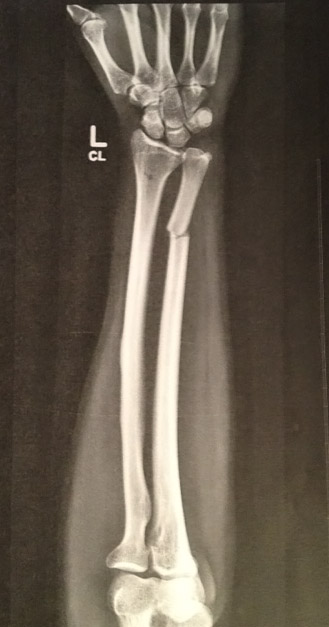Being aware of something is just the first stage of learning. Feel it in your bones is the only way to own it.
I know about bone mass / density for quite a while. I am physically fit and been active for most of my life. I done lots of bag work in my early years. So all the talks about “losing bone mass as you age” is meant for everybody else but me.
Well last Tuesday, I finally got my wake up call – my left forearm cracked while doing impact drills with Brian. We did hear a pop but there wasn’t any sharp pain and we continued for a few more hits. I iced it at home but I felt a click when I twist my wrist and so I head to the emergency for an X-ray (on the right) the next morning. So I will be in a cast for 4-6 weeks.
Despite the mishap, there is a silver lining – I rather get injured under friendly fire and learn from it. This will spark some changes in how we train as well. Last but not least, I now give credit to the free advises from my family about vitamin D, calcium and being more careful. 😉
My learning:
- Training you get from desensitized nerves or increased pain tolerance is part of neural training. It preserves better than bone mass as you age.
- Weight bearing exercises help in bone density. Jumps are great for hips and spine. Punching bag work, weight lifting all helps. Each exercise has its strength and weaknesses and so shouldn’t be exclusive – just one of the necessary ingredients or stimulus.
- Bone loss is very real regardless of how active you have been. Besides exercising, diet is important. As Orientals, we don’t have enough calcium from our diet. Good diet AND weight bearing exercises do help in reducing the RATE of loss but doesn’t eliminate it totally.
- Absence of pain is both a good and bad thing – great that I am still functional at the time but bad in that I could have done additional damages.
- In a real fight, with adrenaline pumping, it is totally possible that an injured opponent can still cause damages, so again. it is not finished until the job is completely done. Over eager leave you exposed, not capitalizing on the damages allow your opponent to recover.
- Impact drills are needed to get to know how direct impact without pads feels like. We need to be desensitized enough not to be shocked on first contact. Hence, controlled impact by yourself should still be done. However for partner impact drill, we should be a little bit more careful – full swing of baseball bat against baseball bat means that eventually one will crack – just a matter of time. We need to be smarter even on toughness training – having limited mobility for 4-6 weeks is not fun.
- We do push ups and other type of weight bearing upper body exercises. We need to more consistently. Artistic gymnastics have lots of skills requiring the arm to bear the full body weight and you can see the benefit of that from Brian’s physique and bone mass. If you have not reached your prime yet, every bit of effort you put in now means “money in the bank”. If you are past your prime, proper exercise AND diet will slow down the rate of loss!
I just discovered how much I love my left arm despite that I am right handed. Some of the nuisances with one arm:
- Driving a standard shift with one arm in a cast
- Having an itch inside the cast can really drive a person up the wall
- Can’t do set up and tear down by myself with just one arm
- Editing photos becomes such a pain when some of the commands require 2 hand operation.
- A 2 finger typist now become a 1 finger typist. My productivity in coding is right down the drain.
Exercise
Complete last week’s blog. Not enough thoughts or observations from your comments.
Class is still on despite my broken arm. 🙂

